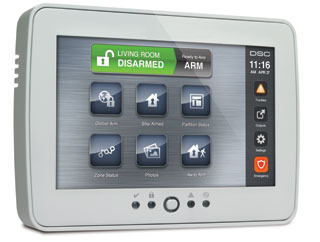Security Alarm Systems & MonitoringWhy Us?When you're looking for a intrusion alarm system, we've got the experts to deliver you a high quality, fully backed product. You want a system that is as easy to use as it is functional and reliable. We will provide the best equipment match for your requirements installed using best practice methods. We are Ministry Justice approved and Licensed Electricians so your insurer will be happy too.
Security Alarms SystemsThe most useful burglar alarm systems have certain characteristics. Systems must be designed to withstand the environments in which they are placed. If a component will experience wide temperature variations, such as in an exterior environment, the equipment must be designed to with stand those variations without failing. Alarm control and detection components and systems should be designed to last a long time. The individual components should be reliable and have a long mean time between failure (MTBF) A reliable system requires less maintenance and is more trusted by operators. Other aspects of reliability include reliable communication and display of alarm data with no loss of information Security Alarm System ComponentsThe typical security alarm system consists of the following basic components: Detection DevicesThe most commonly used types of detection devices at commercial facilities are: Contact SwitchesContact switches are installed on gates, doors and windows to detect when they are opened. Motion DetectorsMotion detectors are used to detect the presence or movement of people in and around building. Glass Breakage DetectorsGlass breakage detectors, as their name implies, are used to detect the breakage of glass. Signalling DevicesSignalling devices are activated when a security breach is detected. Signalling devices serve three purposes:
There are both audible siren and visual types of signalling devices. Signalling devices are normally installed on both the interior and exterior of the building. Arming StationsArming stations are the devices used to “arm” (turn-on) and “disarm” (turn-off) the security alarm system The two most common types of arming stations are keypad arming stations and key switch arming stations Both the key switch arming station and the keypad arming station normally provide alarm system “status indicators”. Status indicators are used to give the user visual information concerning the status of the security alarm system Arming stations are the primary device that the you use to interact with the building’s security alarm system Control EquipmentSecurity “control panels” are the heart of the security alarm system. The security alarm control panel is used to process all system operations and activity. Most modern control panels are actually a specialized form of micro-computer which include a microprocessor, computer memory, and data communications modems. These control panels are fully programmable to allow the operating characteristics of the security alarm system to be custom-tailored to meet the needs of the building in which it is installed Because the average user of the security alarm system usually never needs to interact with the control panel, these panels are normally installed in a secure closet or equipment room Alarm Transmission EquipmentMonitored alarm systems use transmission equipment to communicate alarm events and system activity to an off-site location, such as an alarm monitoring central station. This can be achieved by phone line, IP over Internet and GSM wireless Security Alarm Design ConceptsThere is a great deal of flexibility in the way an Security alarm system can be designed for a building. The designer has a great deal of latitude in selecting the quantity and type of equipment that will be used, and in determining where this equipment will be located While each different system designer has his or her own idea of what the best arrangement of detection devices is, there are four basic design concepts which are commonly used: Perimeter Protection ConceptThe perimeter protection concept provides detection at the exterior of a building or perimeter of the entire facility. The goal of perimeter protection is to detect the intruder at the point of entry. Interior Protection ConceptThe interior protection concept provides detection within the interior of the building. The goal of interior protection is to detect the intruder inside of the building. Complete interior protection requires that motion detectors be installed in every room and corridor of the building. Interior protection can also be achieved by installing contact switches on the interior doors of the building. Combined Protection ConceptThe combined protection concept fully combines the detection capabilities of both the perimeter detection concept and the interior protection concept. Hybrid Protection ConceptThe hybrid protection concept utilizes some portions of the perimeter protection concept, and some portions of the interior protection concept. The goal of the hybrid concept is to take advantage of the benefits of both perimeter and interior protection, while at the same time keeping the cost of the system below the cost of the fully combined system described above. There is a great deal of flexibility in the way a hybrid system can be designed. The designer may choose to provide full perimeter protection in some portions of the facility, and choose to have only partial perimeter protection in other parts. The same is true with interior protection, complete interior protection can be provided in some areas, while partial or no interior protection can be provided in other areas. |
||
Need Alarm Systems and Monitoring? Call us |
||
If you're interested in reliable, effective and easy to use security
For an obligation free chat, simply give us a call on 0508 22 88 66 or contact us by email and we'll be in touch fast. |
||





